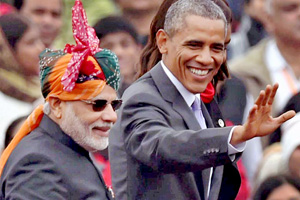New Delhi, Jan 26: The India-US CEO Forum began Monday with Indian Prime Minister Narendra Modi and US President Barack Obama present along with top business honchos of both countries.India Inc is led by Tata Group chairman Cyrus Mistry.
The other CEOs who are expected to be present are Mukesh Ambani, chairman and managing director (CMD), Reliance Industries Ltd; Gautam Adani, chairman, Adani Group; Sunil Bhari Mittal, chairman and group CEO, Bharti Entreprises; Sashi Ruia, chairman, Essar Group; Hari S Bhartia, co-chairman and MD, Jubilant Life Sciences; and Kiran Mazumdar Shaw, CMD, Biocon.
Among others are Anand Mahindra, CMD, Mahindra and Mahindra; Deepak Parekh, chairman, HDFC; Chanda Kochar, CEO and MD, ICICI Bank; Arundhati Bhattacharya, chairman, State Bank of India; Vishal Sikka, CEO & MD, Infosys; B Prasada Rao, CMD, Bharat Heavy Electricals Limited; Sudhir Mehta, chairman emeritus, Torrent Pharmaceuticals; Preetha Reddy, executive chairperson, Apollo Hospitals Entreprises; Anurag Kumar, director, Indian Institute of Science, Bangalore; and D.K. Saraff, CMD, ONGC.
Honeywell International Chairman and CEO Dave Cote was likely to lead the US CEOs team, which was to have Indra Nooyi, chairperson and CEO, PepsiCo, and Ajay Banga, CEO, Mastercard, among others.
US-India Business Council (USIBC) acting president Diane Farrell told IANS: "The Forum will be focusing on two-way trade. Ease of doing business is something that will be focused. That will attract more US business to India.
"Market access issue of both the countries will be discussed. US companies recognises the importance of both these programmes of Digital India and Make in India. The US companies will look at the consistency and predictablity of Indian market."





Comments
Add new comment